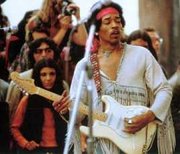Stratocaster
|
|
Stratocaster_DSC06934.jpg
- Strat redirects here. For the drinking game see: Strat (drinking game).
The Stratocaster is a model of electric guitar designed by Leo Fender in the early 1950s, and manufactured continuously to the present. The Stratocaster has been used by many leading guitarists and on many historic recordings: Along with the Gibson Les Paul and the Strat's older cousin, the Fender Telecaster, it is one of the most enduring and popular models of electric guitar in the world.
The Stratocaster has been widely copied, such that 'Stratocaster' or 'Strat' can also denote a type of guitar, by various manufacturers, showing the same general features as the original (see strat copy). But properly, and to all legal intent, a Stratocaster is always a Fender; and the guitar's popularity shows no sign of abating.
The Fender Electric Instrument Manufacturing Company (now known as Fender Musical Instruments Corporation) developed the first commercial solid-body 'Spanish' (as opposed to 'Hawaiian,' or lap steel) electric guitar in the Telecaster, a simple design whose earliest models were offered under various names beginning in 1950. Though the Telecaster and its variants were successful, many guitar players of the day insisted on using a Bigsby unit, a fairly primitive spring-loaded vibrato device with which players could bend notes up and down with their pick hand. Instead of adding a Bigsby, Fender decided to produce a new, more expensively-made line of guitar with his own design of vibrato. His decision was also influenced by guitarists Bill Carson and Rex Galleon, who requested a contoured body to temper the harsh edges of the slab-built Telecaster; the new body design was based on that of the 1951 Precision Bass.
The name, 'Stratocaster,' was intended to evoke images of newly emergent jet-aircraft technology (such as the Boeing B-52 Stratofortress), and to express Fender's modernistic design philosophy. In designing the Stratocaster's body, a significant area of the back of the guitar, and the area where the strumming arm rests, were beveled to accommodate the player's chest and arm. The upper bouts featured two cutaways, for easier access to the higher frets. The new 'Custom Contour Body' and 'Synchronized Tremolo' bridge made the Stratocaster a revolutionary design. The guitar also featured more complex electronics than the Telecaster: a then unheard-of three single coil pickups, each with staggered magnetic poles; a three-way selector switch; one volume knob, and two tone controls. Patents were applied for, for all these new designs, and production line Stratocasters reached the market in early 1954 for $249.50. The basic production model had a two-tone nitrocellulose 'sunburst' finish, chrome hardware, and Bakelite plastic parts. Other manufacturers began imitating these innovations immediately.
Much of the popularity of the Stratocaster can be attributed to its versatility. The neck, middle, and bridge (in the original manual, labelled "rhythm", "normal tone", and "lead", respectively) pickups provide a wide range of tones; the Stratocaster has been used for a variety of purposes, from the classic "Fender twang" to the slicing solos of Jimi Hendrix and Eric Clapton to the fat, crunching tones in Ritchie Blackmore's "Smoke on the Water".
The bone-simple Telecaster also remained in production, and both the Stratocaster and the Telecaster flourished into diverse families of guitars, with many variants. Each continues to enjoy its own following among guitarists.
In 1959-1965, the Stratocaster was refitted with a thick rosewood fretboard, as well as color choices other than sunburst. After 1965, one could be purchased with either a maple or a rosewood fretboard. Other, often subtle changes were made to the guitars over the years, as though in the spirit of tinkering for which Leo Fender was famous.
The Stratocaster fell out of fashion in the mid-sixties, to the point where the Fender company (Leo Fender had sold it to CBS for 13 million in January 1965) reduced its price and considered removing it from their production line. However, Jimi Hendrix and many other blues-influenced artists of the late '60s soon adopted the Stratocaster as their main instrument, reviving the guitar's popularity. Another lull occurred in the mid-'80s, during which the Fender company cut costs by deleting features from the standard Stratocaster line. This trend abated by the end of the decade with a rise in mainstream popularity for vintage (and vintage-style) instruments.
Players first perceived a loss of the initial high quality of Fender guitars after the CBS takeover in the early 1960s. So-called 'pre-CBS' Stratocasters are, accordingly, extremely sought-after and expensive. In recent times, original 1954 to 1958 Stratocasters have sold for as much as $20,000. Many now reside in Japan, cached away as collectible pieces of Americana.
See the article on the Fender company for further details on the Stratocaster's various designations and countries of manufacture.
Fender now offers an extensive line of vintage Stratocaster reissues, as well as maintaining a 'custom shop' that builds guitars to order. It also offers 'artist series' guitars, featuring replicas of the Stratocasters played by famous guitarists such as Becky Wells, Eric Clapton (see Eric Clapton Stratocaster), Yngwie J. Malmsteen, Buddy Guy, Robert Cray, Eric Johnson, Dick Dale, Jeff Beck, the late Stevie Ray Vaughan and many others. Other notable Strat players include David Gilmour, John Mayer, Robin Trower, Ritchie Blackmore, Mark Knopfler, John Frusciante, Craig Nicholls and Jimi Hendrix.da:Stratocaster de:Stratocaster nl:Fender Stratocaster ja:ストラトキャスター no:Fender Stratocaster

